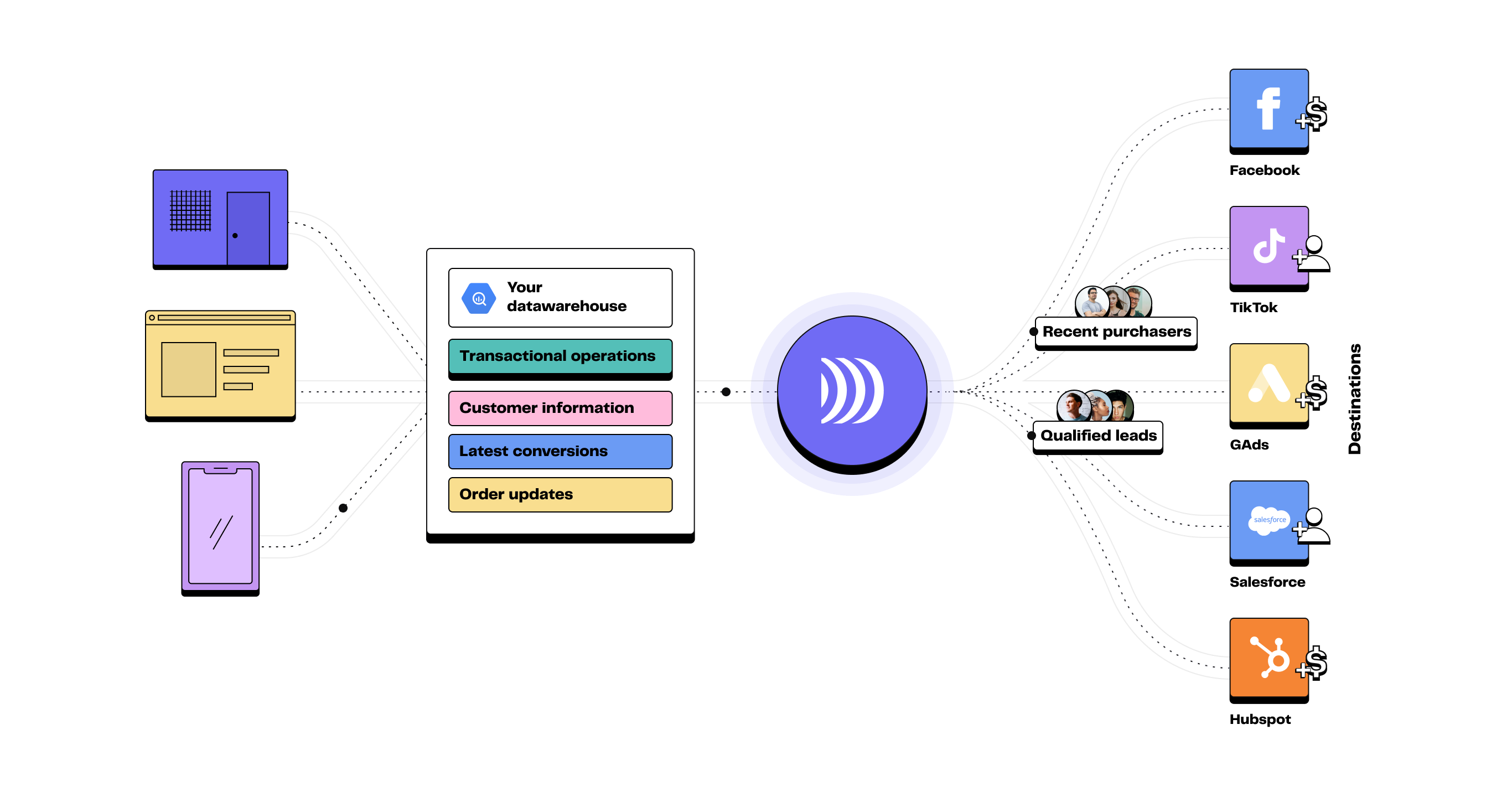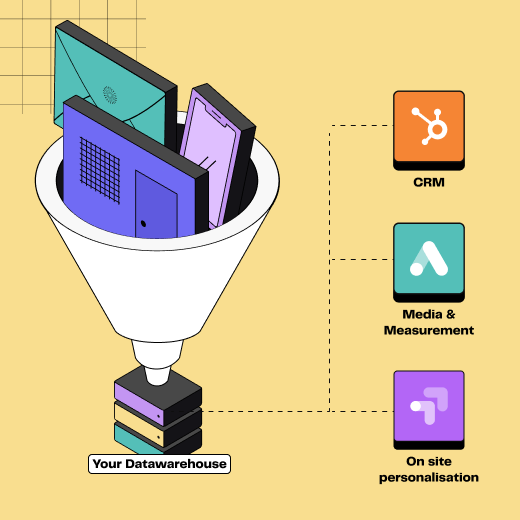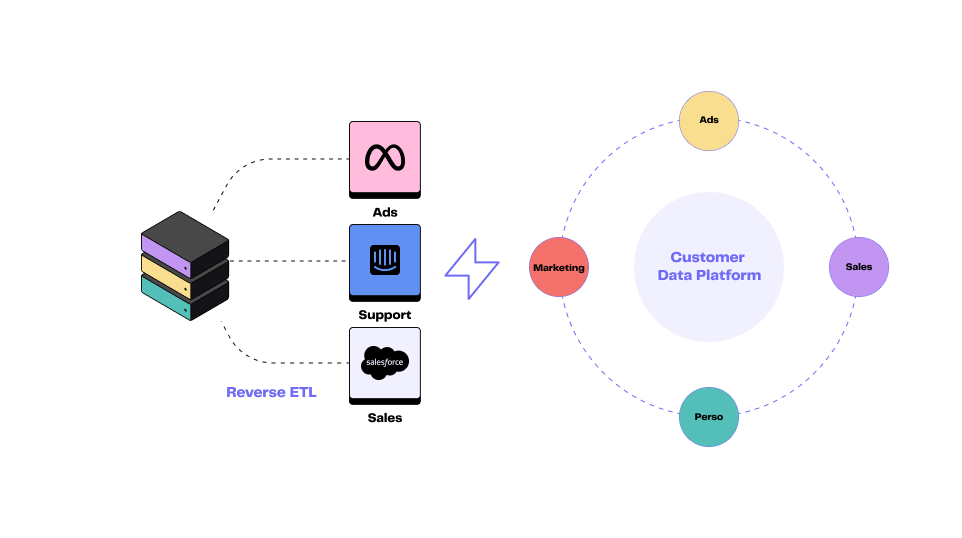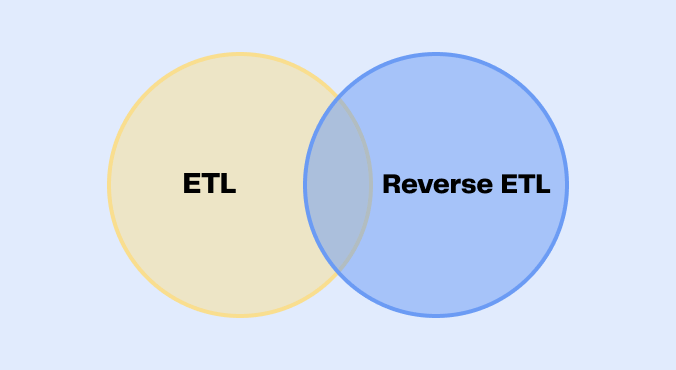Seagate's ‘Rethink Data’ study reveals a surprising fact: companies use only 32% of the data they access. The remaining 68% often resides in data lakes or data warehouses. This makes it inaccessible to non-technical users.
Although this survey dates back to 2020, little has changed since then. This under-utilisation of data is problematic in a data-driven world.
Data has the potential to increase sales, win back customers and improve operations. Here's a figure to illustrate the point: according to McKinsey, the use of first-party data can increase revenues by more than 40% on average.
To harness the power of data effectively, companies need to guarantee its quality. The first steps in making data usable are to break down silos, then consolidate and centralise data into a single source of truth.
The next step is to make this enriched data accessible in everyday operational tools. This is precisely where the Reverse ETL process comes into play.
Key Takeaways:
Reverse ETL is the process by which data from a data warehouse is transferred to business tools.
The main uses are in sales and marketing: optimising advertising campaigns, personalising messages, etc.
Reverse ETLs have also proved their worth in support and finance functions, for prioritising actions and enriching analyses.
To make your project a success, it's important to follow the key steps and avoid common mistakes.
📊 In this article, discover how Reverse ETL transforms your data into concrete actions. Explore their use cases and learn how to maximise their impact on your operational teams.
What is Reverse ETL
In short, Reverse ETL (Extract, Transform, Load in Reverse) is the process of syncing data from a source (in general, a cloud data warehouse) to the cloud applications used by operational (marketing, sales, support, etc.) teams.
The easiest way to understand Reverse ETL is to think of it as a pipeline that connects your source to the rest of your organisation's tools.
There are five main components to Reverse ETL pipelines: sources, models, segments, syncs and destinations. The process is quite basic: syncs segment data from your source directly to your destinations - based on prebuilt models that define how your data is represented.
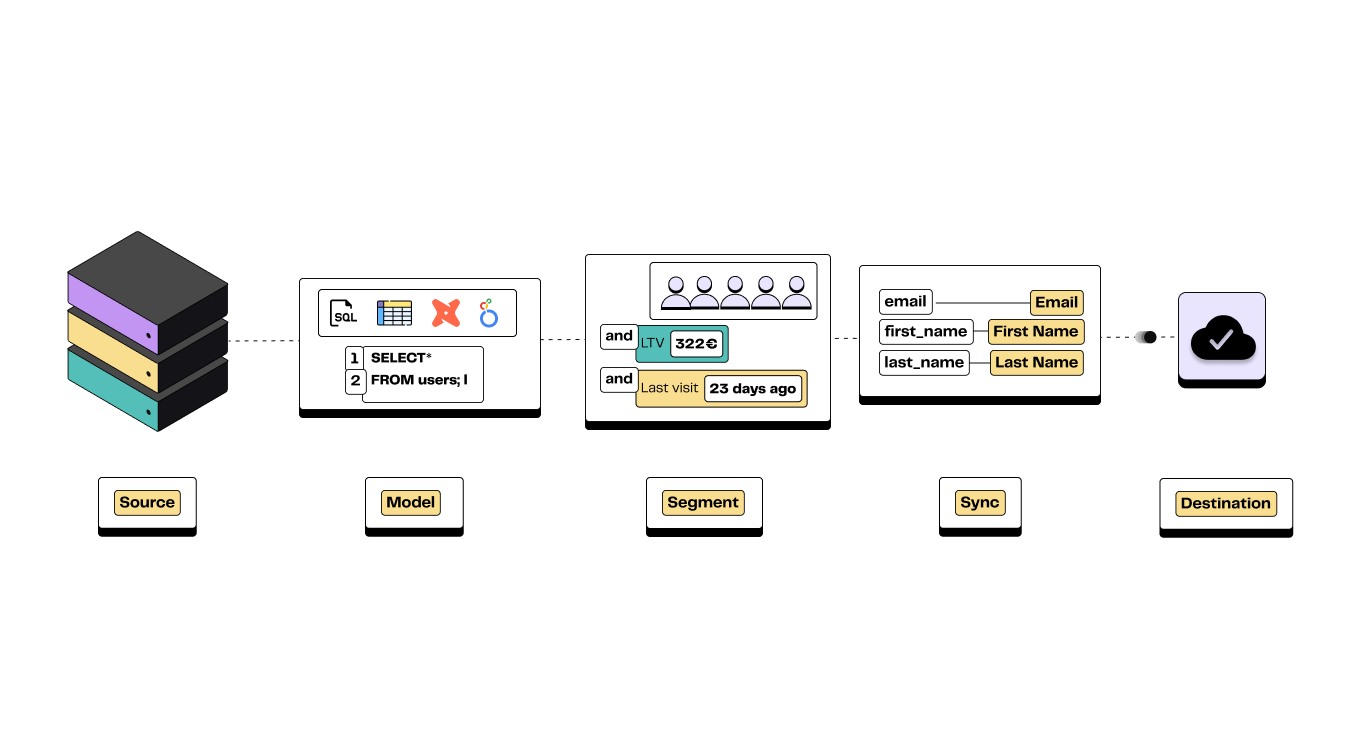
Core components of Reverse ETL
This process turns your existing data stack into a Composable CDP so you can improve business operations.
What is Reverse ETL used for?
Reverse ETL is becoming increasingly important as organisations seek to capitalise on the wealth of data they collect. This data comes from business applications and databases and is used for operational analysis, automation and/or personalisation of customer experiences.
Reverse ETL comes with several benefits:
Data operationalisation: Data sitting in your warehouse has potential value, but isn't exploited at all. However, it's when this data is activated in business applications, it gives valuable insights and unlocks untapped growth opportunities.
All departments in a company can benefit from this data activation process: marketing, finance, customer support, sales, and even data teams!
Time savings: From a data team perspective, the main benefit of Reverse ETL is the automation and reliability of sending data to business platforms.
Rather than building and maintaining APIs or writing SQL for segmentation purposes, the only thing they have to do is to ensure that the data is available in the data warehouse (or another single source of truth). This means plenty of time to focus on real value-added tasks.
Disclaimer: your data stays in your data warehouse. Reverse ETL platforms only read it but never store it!
Prevention of data silos: Reverse ETL tools provide access to data across your entire company. For instance, sales representatives are not restricted to their sales data alone.
This approach breaks down data silos, so you no longer need to constantly request another team or data analyst to generate a list or report. Instead, you can load the relevant data directly into your application and use it as you want.
Data consistency: data stays consistent and up-to-date across all systems. Although operational teams work different SaaS systems, they use the same data which brings continuity across the whole business.
By automating the flow of data between different systems bidirectionally, you can streamline business processes and reduce manual data entry and reconciliation efforts. This not only saves you time and resources but also minimizes the risk of errors associated with manual data handling.
Real-time decision-making: Reverse ETL allows syncing data from your data warehouse into operational systems near real-time. It enables faster decision-making based on the most up-to-date information.
This is crucial in dynamic environments where timely actions can make a significant difference. Real-time insights can help you identify patterns and trends, predict customer behavior, and optimise business performance.
Analytics: With Reverse ETL, you can easily integrate data from various sources to create a 360° view of your business in a unique tool.
This comprehensive data set empowers data analysts and business intelligence teams to conduct in-depth analysis, uncover hidden insights, and inform strategic decision-making based on real-time data.
Concrete use cases by business line
Modern businesses are increasingly adopting what we call operational analytics. This approach involves making data available to business teams (sales, marketing, support).
It differs from the traditional approach of using data solely for reporting and strategic analysis. Rather than using it to shape long-term strategy, operational analytics feeds into the day-to-day operations of the business.
In essence, it uses the company's data to empower everyone in the organisation to make more informed decisions.
That's where Reverse ETL can help:
Marketing campaigns
The Reverse ETL process leverages your existing data stack to allow automated and personalised customer experiences, all along the customer journey:
Ads
Advertising is one of the largest use cases for Reverse ETL because marketing teams often require segments to upload and use for their audience strategies. Reverse ETL allows you to integrate all social media platforms into your data stack, allowing multichannel approaches which are now considered best practice.
Reverse ETL features like our "Visual Segment Builder" can help easily segment the customer database and create audiences that can be used for retargeting, lookalike, or exclusion strategies. It allows you to offer customers targeted ads based on the segments they belong to.
You can even sync both online and offline conversion data from your warehouse to your ad platforms. Sending conversion data is key to better understand the customer journey and feed algorithms used in audience strategies.
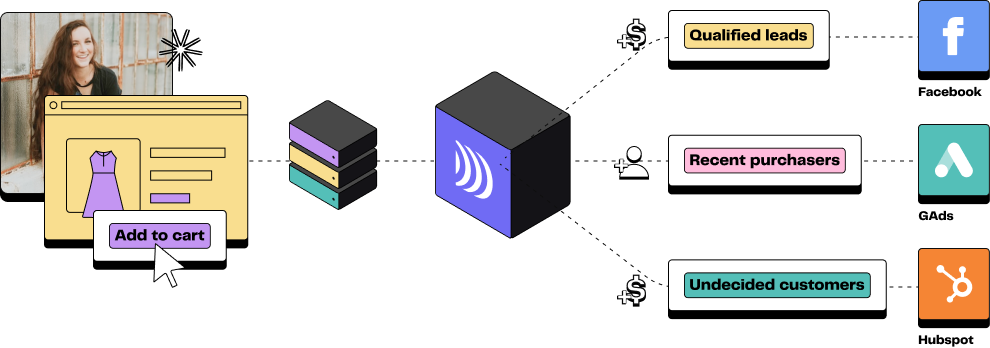
DinMo can sent all conversions to any platform
Moreover, bidding strategies can intelligently be adapted according to conversion events to obtain better results. As an illustration, you can adjust conversion values based on what matters the most to you. For example, a user's sign-up can take different values*:
0 if the lead is not qualified at all
10 if the lead is attractive
100 if the lead corresponds to your ICP
⚠️*The values should be adapted to your average shopping basket.
The algorithm will, therefore, optimise itself to capture as many qualified leads as possible.
Adjusting conversions also makes it possible to move from value-based to margin-based management.
Personalisation
Personalisation throughout the customer's lifecycle is probably the second most common use case for Reverse ETL. It allows sending the right communication to the right person, at the right time. Thanks to Reverse ETL, you can segment your entire customer database and automate personalised campaigns. You will find new indicators to personalise your content.
Indeed, by leveraging Reverse ETL, you can send core attributes (e.g. location, age, gender, income, etc.), behaviors (cart abandonment, product viewed, etc.) or custom predictive metrics (risk of churn, expected additional LTV, etc.) to enrich business tools.
You can then create hyper-customised journeys and touch points, unique to each customer. This not only improves customer satisfaction but also boosts loyalty and drives revenue growth.
Most Reverse ETL tools have connectors with most famous lifecycle marketing tool like Braze, Iterable or Batch.
Here are a few examples of use cases you can implement, particularly in your emailing tools:
Set up the most basic ones: personalise your message in the correct language, with the correct name, and sent within the correct timezone
Add dynamic content to your communications: highlight information that drives your customers to action: limited stocks, expiring membership points, time remaining for an offer, etc.
The reverse ETL process can also be used for social proof on emailing. For example, you can show the number of likes or shares on your latest Instagram post directly on your message.
Get different product recommendations based on product sensitivity/resources viewed: for instance, if someone checks several articles on your blog on the same subject, send them a guide about it.
Reactivate customers: after a certain time without a purchase, send personalised messages to your customers to encourage them to buy again. Something like "Do you want to repurchase this item?" for repeated purchases can be really efficient!
In short, Reverse ETLs make it possible to send first-party data to marketing platforms, reducing the cost of customer acquisition thanks to better quality data and improved targeting.
Sales Operations
If you think that Reverse ETL is only for marketing teams, you're wrong. Everybody in a company can benefit from its first party data, starting with sales.
Reverse ETL technology provides a unique advantage that significantly enhances the effectiveness of your sales teams. This advantage consists of providing them with rich, meaningful information that does not naturally exist in their tools.
This could be modelled data, key attributes or product usage data, etc. For example: send to your Salesforce which pages prospects visit most frequently, which products they are interested in etc. This provides valuable information that can influence your sales strategy.
But that's not all. Reverse ETL also allows you to send alerts directly to messaging tools like Slack. These alerts can be triggered when specific accounts or users reach certain thresholds or take certain actions.
For example, if a user interacts with a specific product on your app a certain number of times, a sales rep can be instantly notified. This enables your sales team to proactively reach out in real-time, capitalising on customer engagement and potentially closing a sale.
Therefore, Reverse ETL not only enriches the data your sales team works with but also transforms the way they interact with potential customers, making their approach more timely, informed, and proactive.
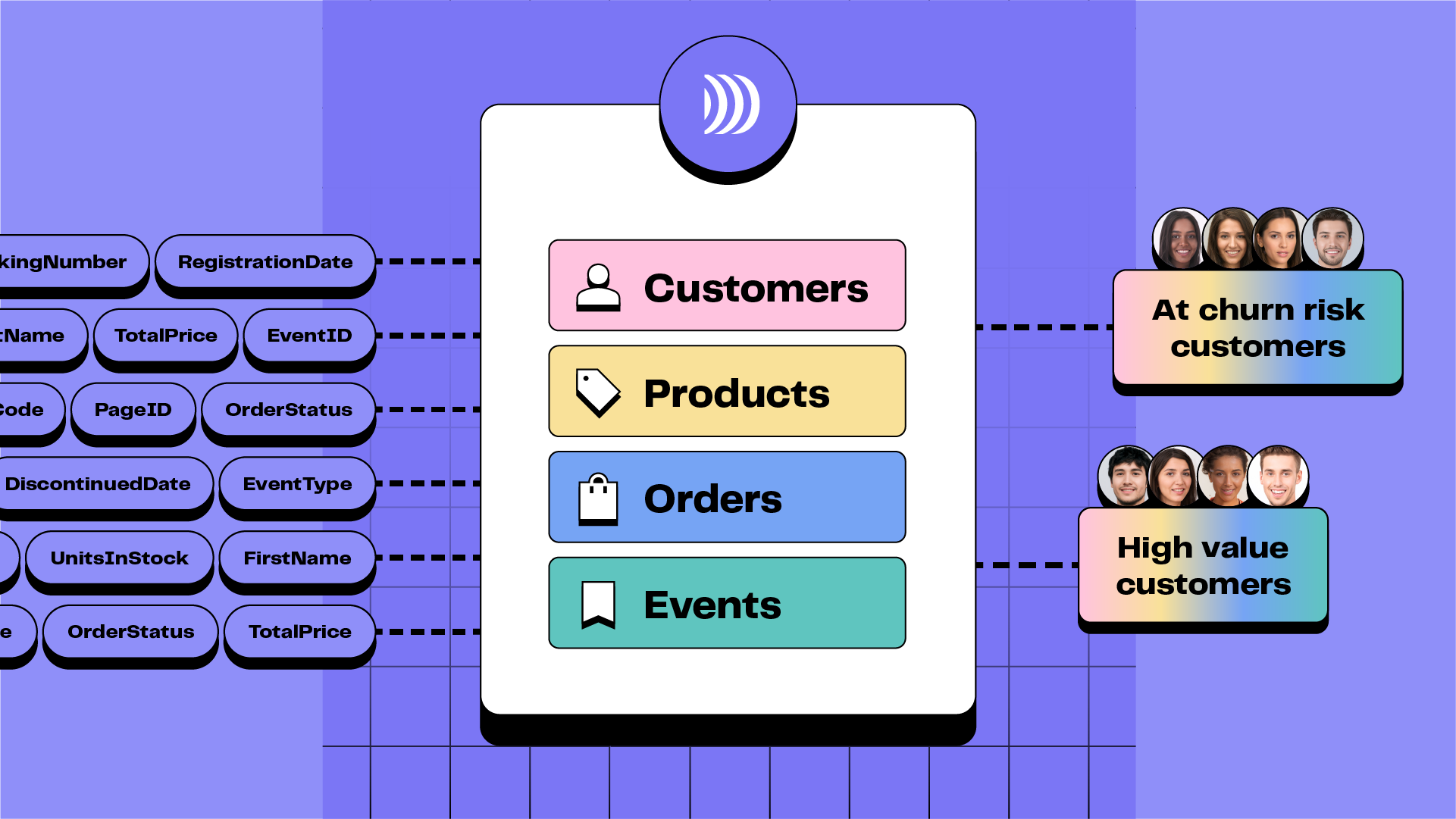
From data modelling to activation
Customer Support activities
In customer support, response time significantly impacts the customer experience. With a high volume of tickets, it's often impractical to address every customer. Prioritisation is crucial, and context plays a key role.
Reverse ETL enables customer support teams to get automated, real-time updates from the data warehouse directly to their ticketing systems. This enhances efficiency and customer satisfaction. Representatives can prioritise and route support tickets based on customer activity, lifetime value (LTV), among other criteria.
And of course, with a comprehensive view of a customer, agents can offer more precise assistance.

Include information about customers at risk of churn in your support tools
Finance
Reverse ETL also has advantages for finance teams as it enables the direct transfer of reconciled financial information, such as revenue, invoices, orders, transactions, and payment details, from the data warehouse to their financial systems.
A practical application of this is the ability for finance teams to customise payment plans for B2B customers and automate follow-ups using invoice tools.
In short, reverse ETL allows data stored in the data warehouse to support all operational systems, providing valuable insights for all departments within the company. This tool is essential for enabling functional teams like sales and marketing to make data-driven decisions and take action on a daily basis.
⚠️ Several categories of Reverse ETL exist, and several players are positioning themselves on the market. Some Reverse ETL tools solve the problem from a data point of view (pipeline construction and maintenance only), without necessarily worrying about the resulting use cases. Others really focus on empowering business teams.
Set up your Reverse ETL
Steps to follow
Assess your needs: Identify the business tools to be connected and the data required by your teams.
Choose the right tool: Check compatibility with your destinations, no-code functionalities and security options.
Configure your connections: Link your data warehouse to operational tools by defining the data models and segments to be synchronised.
Test synchronisation: Check that the data is correctly transferred and usable in the business tools.
Monitor performance: set up an observability system to detect and correct errors quickly.
It's apparent that data warehousing continues to be crucial for modern businesses looking to compete in the digital age. To get the most out of your first party data, it's essential to consider reverse ETL as a key component of your modern data stack.
By integrating your data warehouse with operational systems, you empower your teams to make timely and informed decisions, ultimately leading to a better customer experience, increased revenue, and business growth.
Mistakes to avoid
Ignore business needs: Ensure that operational teams can easily exploit the data provided, using no-code functions for example.
Neglect security: Validate compliance with regulations (GDPR, CCPA). Tools offer hash functions and robust encryption protocols.
Underestimating hidden costs: Take into account any limitations or charges linked to data volumes. Synchronisation in real time is only carried out for use cases that require it.
Forgetting to test: Failure to validate data transfer can lead to critical errors in operational tools.
We have illustrated just a few of the possible use cases made possible by reverse ETL. But there are plenty of other cases that could benefit your business that we can discuss, and above all implement.
🚀 Want to check it out? See how our DinMo's Reverse ETL platform works with a free demo.
💡If you'd like to find out more about how Reverse ETL can benefit your company or need help with data activation in general, please don't hesitate to contact me: alexandra@dinmo.com
FAQ
What are the main uses of Reverse ETL?
What are the main uses of Reverse ETL?
A Reverse ETL is used to synchronise data centralised in a with business tools.
The most common use cases include :
- Optimising marketing campaigns using precise audiences,
- Enhancing sales tools with up-to-date customer information,
- Improving customer support with real-time data.
- Financial teams can also automate complex analyses.
In short, Reverse ETL offers concrete applications for all the functions of a data-driven business.
How can Reverse ETL improve my marketing campaigns?
How can Reverse ETL improve my marketing campaigns?
Reverse ETL makes it easier to segment audiences and personalise advertising campaigns. It enables first-party data (such as purchasing behaviour or loyalty scores) to be synchronised directly with marketing platforms.
This helps to target customers more effectively, exclude irrelevant groups and create lookalike audiences. The result: more relevant campaigns, higher ROI and optimised advertising budgets.
What is the impact of Reverse ETL on first-party data and compliance?
What is the impact of Reverse ETL on first-party data and compliance?
Reverse ETL simply reads first-party data already centralised in your data warehouse. This gives you greater control. This data is then activated in your tools while complying with regulations such as the GDPR or the CCPA.
Thanks to robust security protocols, hashing and encryption functions, it minimises the risks of non-compliance. By using this data responsibly, businesses can strengthen the trust of their customers.

















